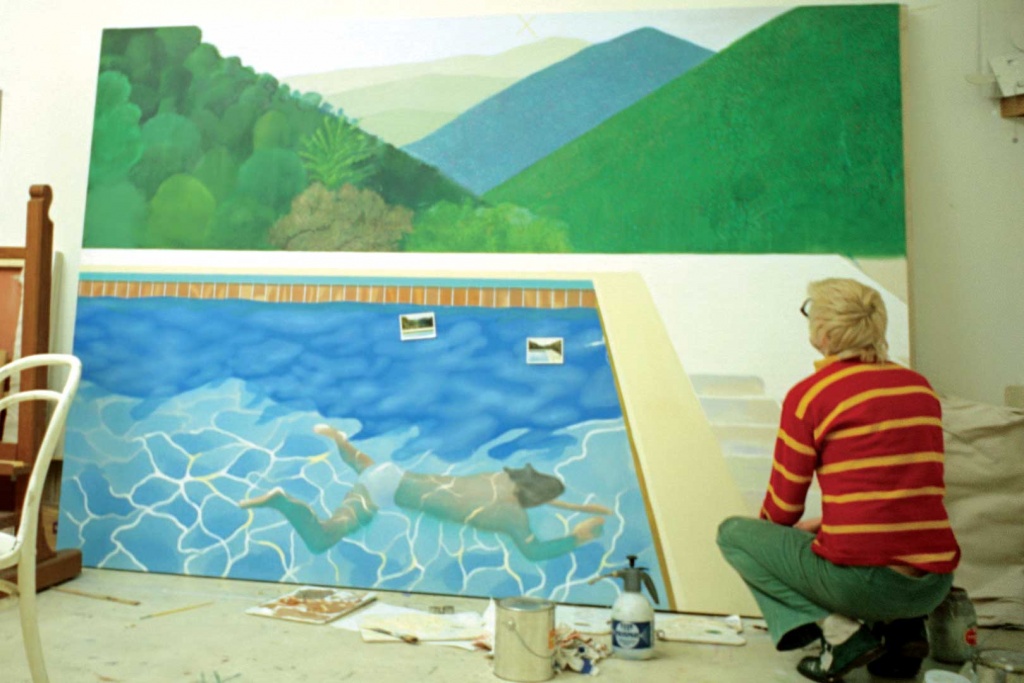Director Jack Hazan’s 1973 quasi-documentary about gay artist David Hockney, “A Bigger Splash,” takes its name from the title of one of Hockney’s seminal paintings.
The film depicts the artist’s breakup with Peter Schlesinger, his one-time lover and muse, and the impact that had on him, his work, as well as his coterie of friends.
Before the screening of a 4K restoration at Lightbox Film Center on Aug. 10, 7 p.m., Hazan talked to PGN about making the film, working with David Hockney and how “A Bigger Splash” has made waves for nearly 50 years.
PGN: How did you come to make this film and what prompted the quasi-documentary approach?
JH: It crosses the genre, which was a real problem in the States in 1974. They couldn’t understand it. They rejected it. But it was perfectly natural. How it started? We wanted to make a feature film. We weren’t standard filmmakers from the film industry. We had a big background in documentaries. David Mingay, who was the film’s editor, and I both worked in the BBC. [Mingay] showed me a catalog of Hockney’s work, and it looked filmic. I got hold of David Hockney. I asked to make a film, and he said “Jack, I’m not going to act.” I managed to cajole him into doing a bit of filming. It was a cross between Warhol and Antonioni, using feature-film grammar.
PGN: Why did the breakup become the backbone of the film?
JH: That’s me imposing a narrative on what happened. That’s my narrative drive. All the relationships collapsed once David and Peter’s relationship collapsed. That’s an allegory, or a metaphor. That’s not really what happened.
PGN: How did you work with and film David?
JH: David was totally obsessed with painting, so when I gained access to his studio or apartment, I was on my own with him, and I could shoot things rapidly. A big heavy crew would have been impossible. Everyone asks about the shower sequence. [Hockney is filmed taking a shower.] I got in the shower with him! After we filmed that, he said, “Jack, you’re mad!” Generally, I shot just one take — two at the most — because he didn’t want to be disturbed. I would ask him to go from here to there and then edit it with another shot to create meaning. I rarely disturbed him. He was totally charming, and democratic — he never dismissed anyone as unimportant. And, as I said, he was obsessed with painting.
PGN: Did you “collaborate” with Hockney in determining what to film or how to shoot the art scenes?
JH: David didn’t collaborate with me in any way. He didn’t know what I was doing. But don’t forget, I didn’t know what I was doing in the beginning! When I shot the scene of David painting Peter on the stool in the studio for the first time, David Mingay said, “There’s your story: They broke up, and everything follows from that.” I had to consider that for a while — it’s too intrusive — but that became the story. It was filmed out of sequence. I didn’t know what I was going to do with the shots until it was made. I was led by this scene of the breakup and how it impinged on David’s ability to work and finish the painting.
PGN: I recall the film was banned on release due to two men coupling; there are also some scenes of nude men frolicking in a pool. Can you talk about the film’s emphasis on nudity and sexuality?
JH: Someone said it was pornographic! It’s not there to titillate you. That’s how it was! There was no other way to portray it. We were opportunistic to show this coupling of Peter and this other person. We knew it would produce a reaction, but we didn’t think it would lead to a censorship ban in France — which was overturned. And in Britain, they leaned on the censor for an X certificate. But that’s how it was! It’s a gay milieu.
PGN: How did Hockney react when he saw the film?
JH: He never knew what I was doing. Only after I showed it to him did he know what the film was about and he was totally shocked — he had to relive his breakup! He had no idea that that was the story. He disappeared for a couple of weeks.
PGN: How do you think the film holds up after nearly 50 years?
JH: It’s not for me to say, but I think it does hold up compared to other films from the period.
